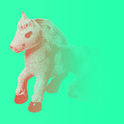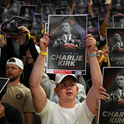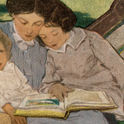“It is now two minutes to midnight,” reads the latest annual bulletin from the Doomsday Clock. The clock, which maps how close we are to mass destruction, has come forward by thirty seconds this year; the closest it has ever come to midnight.
It’s a terrifying little thing. We are—so they say—closer to the end of the world than ever.
The news, it’s true, gives me a sense of impending disaster quite regularly. But I can’t help but wonder: who is this clock for? Who is this helping?
It’s not for the people who can do anything about it; for if they wanted to they’d have done it already. They already know what they are doing (and please, don’t let’s try and pretend they don’t). All the well-informed thinkpieces in the world are unlikely to change nuclear policy.
Is it for us, then, the people who can’t do anything about it? So at least we know that a group of scientists think we’re a little bit more likely to die than we were last year?
Well, we’re all going to die. That—as someone else once observed—is what people do.
“The risk to global civilisation,” pronounced the Guardian, solemnly, “is as high today as it has ever been”.
Well—perhaps. I’m not saying we aren’t in terrible danger; I think we probably are, if everyone says so. But here’s the thing: that little word “ever” is working awfully hard. The Doomsday clock has been running for seventy-one years, since 1947.
If we borrow the metaphor and map the history of the Earth onto a twenty-four hour clock, with the formation of the globe at one minute past midnight, humans haven’t even been around for two minutes.
If we then imagine that period mapped onto a 24-hour clock, everything from the Year 0 AD—the entire Common Era, the whole time since Jesus, all 2018 years of it—has apparently only been around for fourteen minutes.
Seventy-one years is a long time, for a human. For humanity, it’s almost nothing. For the Earth itself, it’s a hair past a freckle.
“The most danger we’ve been in for seventy-one years” is different to “ever”. Put in context, the Doomsday Clock the kind of historical did-they-see-it-coming puzzle that future archaeologists will pore over for hours long after we are gone—the way we do over Mayan calendars and pyramids.
For we are not, of course, the first civilisation to ponder our own demise. And we probably won’t be the last. All civilisations fall, in the end—and almost all of them are obsessed with falling.
It is no surprise, then, that we are culturally obsessed with apocalypses. There are endless films and TV shows and novels and comics and video games and Reddit “prepper” threads and drunk dinner party conversations about what, exactly, it might be like.
It doesn’t matter what kind of apocalypse it is. Natural disasters were huge for a bit there; then zombies and other pandemics. Climate change is good too. If there isn’t already a disaster movie about antibiotic resistance, I’m sure it’s coming. But right now—with Trump holding the nuclear football—it’s mostly good old-fashioned Cold War-style nuclear Armageddon.
These are fantasies even if they are coloured with dread. The only two certainties in life, notoriously, are death and taxes, and the apocalypse neatly uses one to blot out the other. Tired of the commute and the news and trying really hard to recycle? Tired of waiting for the worst thing to happen? Well, what if it did?
It might even be better, once we’ve got rid of all those irritating trappings of modern life. No more distracting internet. No more pollution. No more “chemicals.”
It may be happening already, this secret wish to get rid of millennia of civilisation, masquerading as a love of the authentic and “natural”. It’s middle-class parents keeping their kids away from the MMR when measles, unchecked, kills millions. It’s the fad for “raw water” while cities like Cape Town and Flint fight for the opposite. It’s sourdough bread and unsterilised hipster pickle jars and essential oils instead of medicine. In each silly fad, there is a deeper longing to start afresh.
This urge, our myths remind us, is part of our humanity. Think of Noah and his ark, for example—or rather, think of all the flood myths all over the world, because almost every part of the world has a flood myth. They tell how a great force beyond our control came, and everything on dry land that had the breath of life in its nostrils died. There are ancient Mesopotamian myths and Norse myths about this; Greek myths, Chinese myths, and Indian myths; there are flood myths from Native American tribes and Australian Aboriginal tribes and all the places in the world where the Abrahamic religions are.
We have always talked about the end of the world: as long as there have been people, there have been stories of where we came from, and how that world ended, and prophecies of how this world will end. We came out of Eden; we are waiting for Revelations.
Eschatology means, literally, “the science of last things.” It’s (mostly) a theological term, because the study of apocalypses tends to be, if not purely religious, at least mythological. There are almost always freak astronomical events (suns rising in the wrong place, more suns than usual, suns turning black like sackcloth).
This makes sense, when you think about it. All the apocalypses civilisations have ever known—Ice Ages, supervolcanoes, conquest by an invading force—have rendered them right back down to scattered bands of storytellers. There are frequently horses involved. Almost everyone, everywhere, believes that the dead will walk. After that? Nobody seems sure. It doesn't seem to matter. What matters is the ending.
We love to talk about the end of the world, maybe because it makes us feel less alone in knowing that we are all going to end someday. "Apocalyptic beliefs make existential threats—the fear of our mortality—predictable," a psychologist told Scientific American magazine back in 2012 (when we thought the world might end because of a Mayan prophecy.) Plus, of course, if we know, we can be ready when it comes.
This is why the particulars of our apocalypse fantasies don’t really matter. What matters is that imagining seeing an apocalypse is to imagine surviving it, you and me babe, alone in a hostile world. We’ll knock over a pharmacy and a gun shop; head for the woods; farm things; gather things; hunt things. We’ll be thin from running so much; we’ll be brown and svelte from how outdoorsy we are. We’ll learn to make fire. We’ll find water. We’ll live off the fat of the land. It’s one back-to-the-land back-to-nature farm-to-table off-grid Tough Mudder of a survival challenge, and by God are we going to survive.
Euhemerism, which is the belief that myths come from historical events, suggests that this flood—or at least, a flood—was real. It happened, and we remembered it. We passed it down in myths and legends, to remind us that we are the descendants of the survivors.
This much, at least, we know to be true: we are the descendants—every last one of us—of the people who survived every cataclysmic event the Earth has ever known. We are the descendants of the people who survived the last apocalypse, and they the ones before that, and they the ones before that.
It is almost impossible to think of people in the distant past as people: real people, like us, who felt themselves to be modern and forward-thinking and technologically advanced. We feel instinctively that they must have known themselves to be primitive; their paintings to be childlike; their technology to be silly old stones. We think of them like actors in a story. They weren’t: they lived, and breathed, and survived (until they didn’t), and then—a long time later—there was you.
Perhaps this is why almost everyone believes (secretly or not) that they would be the one- one of the lucky few—to survive, toting a stolen gun and a rabbit-skin cape. We inherited that belief all the way down the old mitochondria. We are—we will be—the survivors.
And perhaps there is, in that, something almost touching. After all, to worry about losing anything, you have to have something to lose. We have to still have some faith in this stupid, messy, polluted, dangerous civilisation to worry that we might lose it.
Perhaps what we need to do is take that ancient faith in ourselves—that left to our own devices, we could do anything, we could make it all ok—and apply it to the world as it is.
The Doomsday Clock statement, this year, ends with a plea to rewind it. “Get engaged, get involved, and help create that future,” writes Rachael Bronson, the CEO of the Bulletin Of Atomic Scientists. “The time is now.”
I don’t know whether we can turn back the clock. It seems to me unlikely that anyone reading this has that kind of power. But perhaps the clock, in the end, is for all of us. Perhaps what we can do, with all that potential we were saving for the apocalypse, is to try to make our particular world a slightly nicer place to remember; a slightly nicer myth to tell.
Apocalypse soon: How I learned to stop worrying and love the end of the world
Just like every culture has its creation myths, every culture has its myths of destruction. And why wouldn't they?
January 26, 2018

The Doomsday Clock is at two minutes to midnight. Who is that meant to help? Photo: Prospect composite












